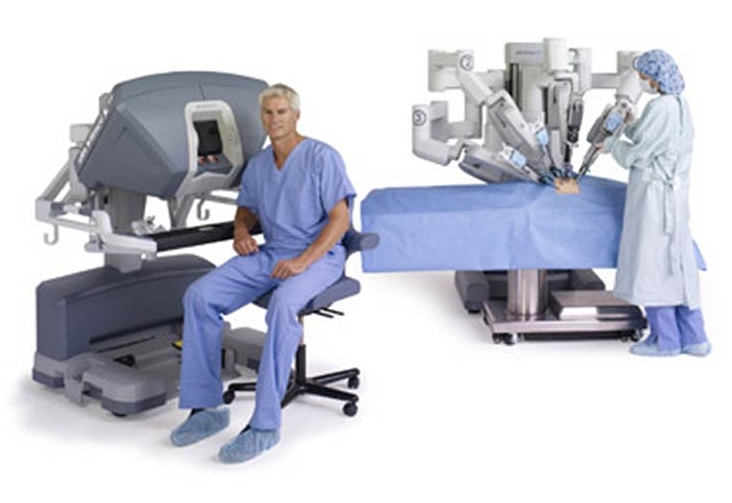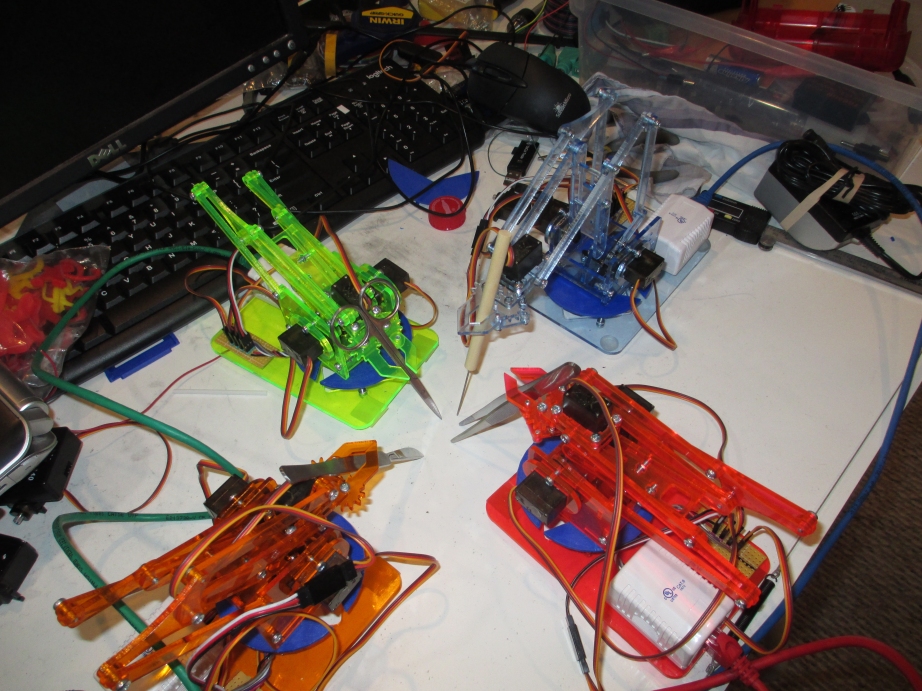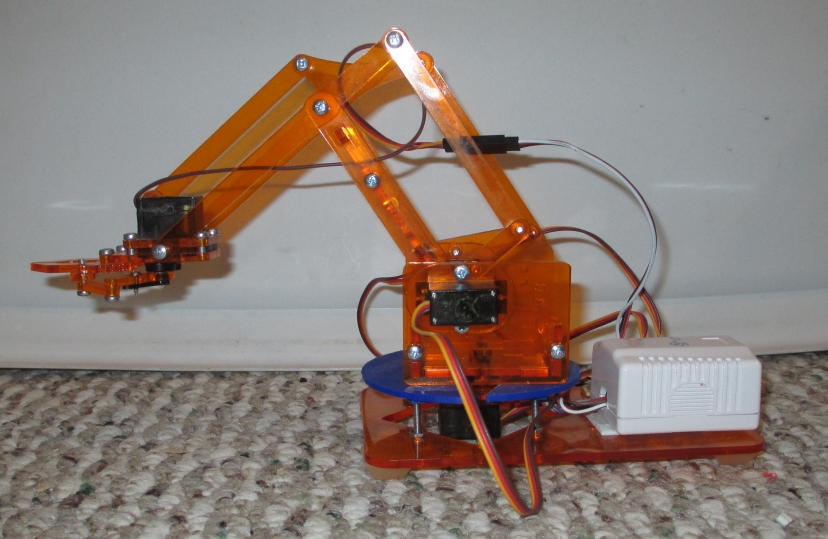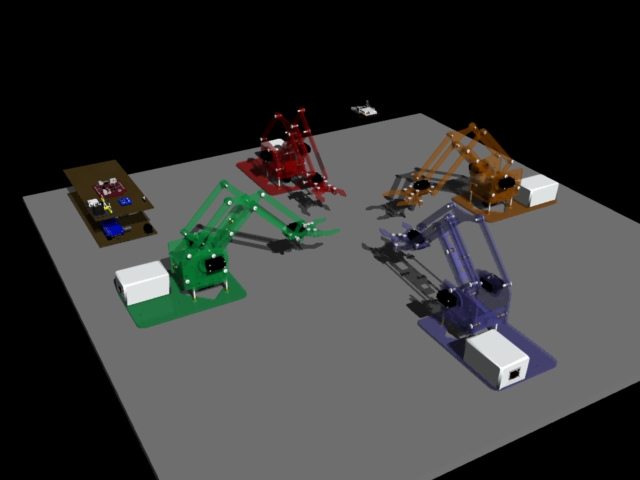Duh-Vinci Surgical Robot
Below is the Multi-Million Dollar Ultra-High Technology Da Vinci Surgical Robot.
And this is the Cheap Low Technology Duh Vinci Surgical Robot.
Tablet Interface
Circuit
Contents
Parts List:
4 x Me Arm Open Source Robot
1 x Dissection Kit
1 x SparkFun Blynk Board
1 x 4 Line Voltage Level Shifter
1 x ESP32-Cam
1 x PCA9685 12-bit 16-PWM Servo Controller Board
4 x Cat6 RJ45 Surface Mount Box - 1 Port
2 x Cat6 RJ45 Surface Mount Box - 2 Port
1 x 5v/3.3V DC Power Supply
1 x 6v DC Power Supply (Servos)
Support Equipment:
1 x Android Tablet
meArm Open Source Robotic Arm
The robotic arms are meArm V0.3 possible V0.4 types. They were made several years ago and have been awaiting this opportunity to be of use to mankind.
This is one of four identical meArms. They differ in color to assist in identifying which arm is being used.
ESP32-CAM Setup
A video stream compatible with Blynk's video-stream widget was necessary. An RTSP would work with Blynk. An Arduino compatible GitHub library was found.
From Geeksville Micro-RTSP GitHub Repository
Under Examples: ESP32-devcam.ino
Modification for selection of correct camera: esp32cam aithinker compatible
#include "OV2640.h"
#include <WiFi.h>
#include <WebServer.h>
#include <WiFiClient.h>
#include "SimStreamer.h"
#include "OV2640Streamer.h"
#include "CRtspSession.h"
#define ENABLE_OLED //if want use oled ,turn on thi macro
// #define SOFTAP_MODE // If you want to run our own softap turn this on
#define ENABLE_WEBSERVER
#define ENABLE_RTSPSERVER
#ifdef ENABLE_OLED
#include "SSD1306.h"
#define OLED_ADDRESS 0x3c
#define I2C_SDA 14
#define I2C_SCL 13
SSD1306Wire display(OLED_ADDRESS, I2C_SDA, I2C_SCL, GEOMETRY_128_32);
bool hasDisplay; // we probe for the device at runtime
#endif
OV2640 cam;
#ifdef ENABLE_WEBSERVER
WebServer server(80);
#endif
#ifdef ENABLE_RTSPSERVER
WiFiServer rtspServer(8554);
#endif
#ifdef SOFTAP_MODE
IPAddress apIP = IPAddress(192, 168, 1, 1);
#else
#include "wifikeys.h"
#endif
#ifdef ENABLE_WEBSERVER
void handle_jpg_stream(void)
{
WiFiClient client = server.client();
String response = "HTTP/1.1 200 OK\r\n";
response += "Content-Type: multipart/x-mixed-replace; boundary=frame\r\n\r\n";
server.sendContent(response);
while (1)
{
cam.run();
if (!client.connected())
break;
response = "--frame\r\n";
response += "Content-Type: image/jpeg\r\n\r\n";
server.sendContent(response);
client.write((char *)cam.getfb(), cam.getSize());
server.sendContent("\r\n");
if (!client.connected())
break;
}
}
void handle_jpg(void)
{
WiFiClient client = server.client();
cam.run();
if (!client.connected())
{
return;
}
String response = "HTTP/1.1 200 OK\r\n";
response += "Content-disposition: inline; filename=capture.jpg\r\n";
response += "Content-type: image/jpeg\r\n\r\n";
server.sendContent(response);
client.write((char *)cam.getfb(), cam.getSize());
}
void handleNotFound()
{
String message = "Server is running!\n\n";
message += "URI: ";
message += server.uri();
message += "\nMethod: ";
message += (server.method() == HTTP_GET) ? "GET" : "POST";
message += "\nArguments: ";
message += server.args();
message += "\n";
server.send(200, "text/plain", message);
}
#endif
void lcdMessage(String msg)
{
#ifdef ENABLE_OLED
if(hasDisplay) {
display.clear();
display.drawString(128 / 2, 32 / 2, msg);
display.display();
}
#endif
}
void setup()
{
#ifdef ENABLE_OLED
hasDisplay = display.init();
if(hasDisplay) {
display.flipScreenVertically();
display.setFont(ArialMT_Plain_16);
display.setTextAlignment(TEXT_ALIGN_CENTER);
}
#endif
lcdMessage("booting");
Serial.begin(115200);
while (!Serial)
{
;
}
//////////////////////////////////////////////////////////////////////////////
//
// DUH-VINCI MODIFICATION
// SELECTION OF AITINKER CAMERA MODULE TYPE "esp32cam_aithinker_config"
cam.init(esp32cam_aithinker_config);
//
//////////////////////////////////////////////////////////////////////////////
IPAddress ip;
#ifdef SOFTAP_MODE
const char *hostname = "devcam";
// WiFi.hostname(hostname); // FIXME - find out why undefined
lcdMessage("starting softAP");
WiFi.mode(WIFI_AP);
WiFi.softAPConfig(apIP, apIP, IPAddress(255, 255, 255, 0));
bool result = WiFi.softAP(hostname, "12345678", 1, 0);
if (!result)
{
Serial.println("AP Config failed.");
return;
}
else
{
Serial.println("AP Config Success.");
Serial.print("AP MAC: ");
Serial.println(WiFi.softAPmacAddress());
ip = WiFi.softAPIP();
}
#else
lcdMessage(String("join ") + ssid);
WiFi.mode(WIFI_STA);
WiFi.begin(ssid, password);
while (WiFi.status() != WL_CONNECTED)
{
delay(500);
Serial.print(F("."));
}
ip = WiFi.localIP();
Serial.println(F("WiFi connected"));
Serial.println("");
Serial.println(ip);
#endif
lcdMessage(ip.toString());
#ifdef ENABLE_WEBSERVER
server.on("/", HTTP_GET, handle_jpg_stream);
server.on("/jpg", HTTP_GET, handle_jpg);
server.onNotFound(handleNotFound);
server.begin();
#endif
#ifdef ENABLE_RTSPSERVER
rtspServer.begin();
#endif
}
CStreamer *streamer;
CRtspSession *session;
WiFiClient client; // FIXME, support multiple clients
void loop()
{
#ifdef ENABLE_WEBSERVER
server.handleClient();
#endif
#ifdef ENABLE_RTSPSERVER
uint32_t msecPerFrame = 100;
static uint32_t lastimage = millis();
// If we have an active client connection, just service that until gone
// (FIXME - support multiple simultaneous clients)
if(session) {
session->handleRequests(0); // we don't use a timeout here,
// instead we send only if we have new enough frames
uint32_t now = millis();
if(now > lastimage + msecPerFrame || now < lastimage) { // handle clock rollover
session->broadcastCurrentFrame(now);
lastimage = now;
// check if we are overrunning our max frame rate
now = millis();
if(now > lastimage + msecPerFrame)
printf("warning exceeding max frame rate of %d ms\n", now - lastimage);
}
if(session->m_stopped) {
delete session;
delete streamer;
session = NULL;
streamer = NULL;
}
}
else {
client = rtspServer.accept();
if(client) {
//streamer = new SimStreamer(&client, true); // our streamer for UDP/TCP based RTP transport
streamer = new OV2640Streamer(&client, cam); // our streamer for UDP/TCP based RTP transport
session = new CRtspSession(&client, streamer); // our threads RTSP session and state
}
}
#endif
}
Modified OV2640.cpp from Micro-RTSP
Modification reduces the video stream to QVGA size (320x240).
#include "OV2640.h"
#define TAG "OV2640"
// definitions appropriate for the ESP32-CAM devboard (and most clones)
camera_config_t esp32cam_config{
.pin_pwdn = -1, // FIXME: on the TTGO T-Journal I think this is GPIO 0
.pin_reset = 15,
.pin_xclk = 27,
.pin_sscb_sda = 25,
.pin_sscb_scl = 23,
.pin_d7 = 19,
.pin_d6 = 36,
.pin_d5 = 18,
.pin_d4 = 39,
.pin_d3 = 5,
.pin_d2 = 34,
.pin_d1 = 35,
.pin_d0 = 17,
.pin_vsync = 22,
.pin_href = 26,
.pin_pclk = 21,
.xclk_freq_hz = 20000000,
.ledc_timer = LEDC_TIMER_0,
.ledc_channel = LEDC_CHANNEL_0,
.pixel_format = PIXFORMAT_JPEG,
// .frame_size = FRAMESIZE_UXGA, // needs 234K of framebuffer space
// .frame_size = FRAMESIZE_SXGA, // needs 160K for framebuffer
// .frame_size = FRAMESIZE_XGA, // needs 96K or even smaller FRAMESIZE_SVGA - can work if using only 1 fb
.frame_size = FRAMESIZE_SVGA,
.jpeg_quality = 12, //0-63 lower numbers are higher quality
.fb_count = 2 // if more than one i2s runs in continous mode. Use only with jpeg
};
camera_config_t esp32cam_aithinker_config{
.pin_pwdn = 32,
.pin_reset = -1,
.pin_xclk = 0,
.pin_sscb_sda = 26,
.pin_sscb_scl = 27,
// Note: LED GPIO is apparently 4 not sure where that goes
// per https://github.com/donny681/ESP32_CAMERA_QR/blob/e4ef44549876457cd841f33a0892c82a71f35358/main/led.c
.pin_d7 = 35,
.pin_d6 = 34,
.pin_d5 = 39,
.pin_d4 = 36,
.pin_d3 = 21,
.pin_d2 = 19,
.pin_d1 = 18,
.pin_d0 = 5,
.pin_vsync = 25,
.pin_href = 23,
.pin_pclk = 22,
.xclk_freq_hz = 20000000,
.ledc_timer = LEDC_TIMER_1,
.ledc_channel = LEDC_CHANNEL_1,
.pixel_format = PIXFORMAT_JPEG,
// .frame_size = FRAMESIZE_UXGA, // needs 234K of framebuffer space
// .frame_size = FRAMESIZE_SXGA, // needs 160K for framebuffer
// .frame_size = FRAMESIZE_XGA, // needs 96K or even smaller FRAMESIZE_SVGA - can work if using only 1 fb
//////////////////////////////////////////////////////////////////////////
//
// DUH-VINCI MODIFICATION RIGHT HERE
// MODIFIED OUTPUT FRAME SIZE TO QVGA
.frame_size = FRAMESIZE_QVGA,
//
//
/////////////////////////////////////////////////////////////////////////
.jpeg_quality = 12, //0-63 lower numbers are higher quality
.fb_count = 2 // if more than one i2s runs in continous mode. Use only with jpeg
};
camera_config_t esp32cam_ttgo_t_config{
.pin_pwdn = 26,
.pin_reset = -1,
.pin_xclk = 32,
.pin_sscb_sda = 13,
.pin_sscb_scl = 12,
.pin_d7 = 39,
.pin_d6 = 36,
.pin_d5 = 23,
.pin_d4 = 18,
.pin_d3 = 15,
.pin_d2 = 4,
.pin_d1 = 14,
.pin_d0 = 5,
.pin_vsync = 27,
.pin_href = 25,
.pin_pclk = 19,
.xclk_freq_hz = 20000000,
.ledc_timer = LEDC_TIMER_0,
.ledc_channel = LEDC_CHANNEL_0,
.pixel_format = PIXFORMAT_JPEG,
.frame_size = FRAMESIZE_SVGA,
.jpeg_quality = 12, //0-63 lower numbers are higher quality
.fb_count = 2 // if more than one i2s runs in continous mode. Use only with jpeg
};
void OV2640::run(void)
{
if (fb)
//return the frame buffer back to the driver for reuse
esp_camera_fb_return(fb);
fb = esp_camera_fb_get();
}
void OV2640::runIfNeeded(void)
{
if (!fb)
run();
}
int OV2640::getWidth(void)
{
runIfNeeded();
return fb->width;
}
int OV2640::getHeight(void)
{
runIfNeeded();
return fb->height;
}
size_t OV2640::getSize(void)
{
runIfNeeded();
if (!fb)
return 0; // FIXME - this shouldn't be possible but apparently the new cam board returns null sometimes?
return fb->len;
}
uint8_t *OV2640::getfb(void)
{
runIfNeeded();
if (!fb)
return NULL; // FIXME - this shouldn't be possible but apparently the new cam board returns null sometimes?
return fb->buf;
}
framesize_t OV2640::getFrameSize(void)
{
return _cam_config.frame_size;
}
void OV2640::setFrameSize(framesize_t size)
{
_cam_config.frame_size = size;
}
pixformat_t OV2640::getPixelFormat(void)
{
return _cam_config.pixel_format;
}
void OV2640::setPixelFormat(pixformat_t format)
{
switch (format)
{
case PIXFORMAT_RGB565:
case PIXFORMAT_YUV422:
case PIXFORMAT_GRAYSCALE:
case PIXFORMAT_JPEG:
_cam_config.pixel_format = format;
break;
default:
_cam_config.pixel_format = PIXFORMAT_GRAYSCALE;
break;
}
}
esp_err_t OV2640::init(camera_config_t config)
{
memset(&_cam_config, 0, sizeof(_cam_config));
memcpy(&_cam_config, &config, sizeof(config));
esp_err_t err = esp_camera_init(&_cam_config);
if (err != ESP_OK)
{
printf("Camera probe failed with error 0x%x", err);
return err;
}
// ESP_ERROR_CHECK(gpio_install_isr_service(0));
return ESP_OK;
}
Blynk Application Information
Video Stream
The video stream is supplied by the ESP32-Cam. It is configured as a RTSP stream. The video-stream widget is configured as :
URL Address: rtsp://192.168.1.19:8554/mjpeg/1
Output : V7
Arm Selection
A Styled_Button-widger is used to traverse the list of me Arms (total of four).
Four LED-widgets are used to display which meArm is active. A LED-widget for each arm is "turned on" representing that arms color. Only one arm is active at anytime. The arms are labeled: SCAPEL, PROBE, TWEASERS and SCISSORS.
Arm Control
Two Joystick-widgets are used to control an arm. The left Joystick-widget controls the X-Y position of the claw. The right Joystick-widget controls the Z position and the Open/Close claw function.
CAD Render
MeArm - 3D
meArm CAD model from GrabCAD with following attributes:
meArm
Nemanja Petkov
December 21st, 2014
MeArm - Pocket Sized Industrial Robotics for Everybody
by Benjamin Gray
Model was modified for this rendering to match the V0.3 variety I have.
PCA9685 - 3D
Module from GrabCAD with following attributes:
16 channel PCA9685
Ali ZAHI
September 22nd, 2016
16-Channel 12-bit PWM/Servo Driver - I2C interface - PCA9685
Model was modified for this rendering to match the variety of ESP32-Cam I have.
ESP32-Cam - 3D
Module from GrabCAD with following attributes: ESP32-CAM
Jan Jezek
May 6th, 2019
ESP32-S module with camera Geekcreit diymore.cc. iges, step, stp
Model was modified for this rendering to match the variety of ESP32-Cam I have.






